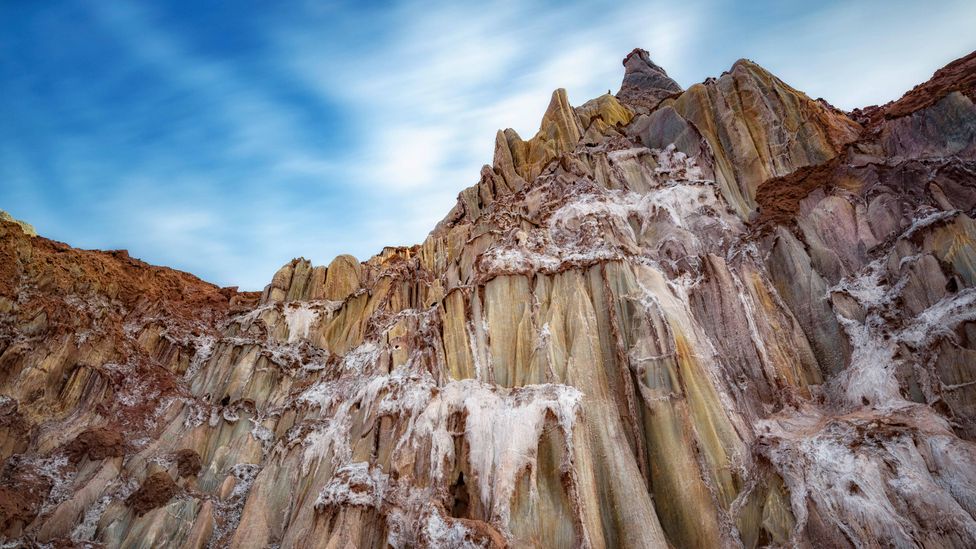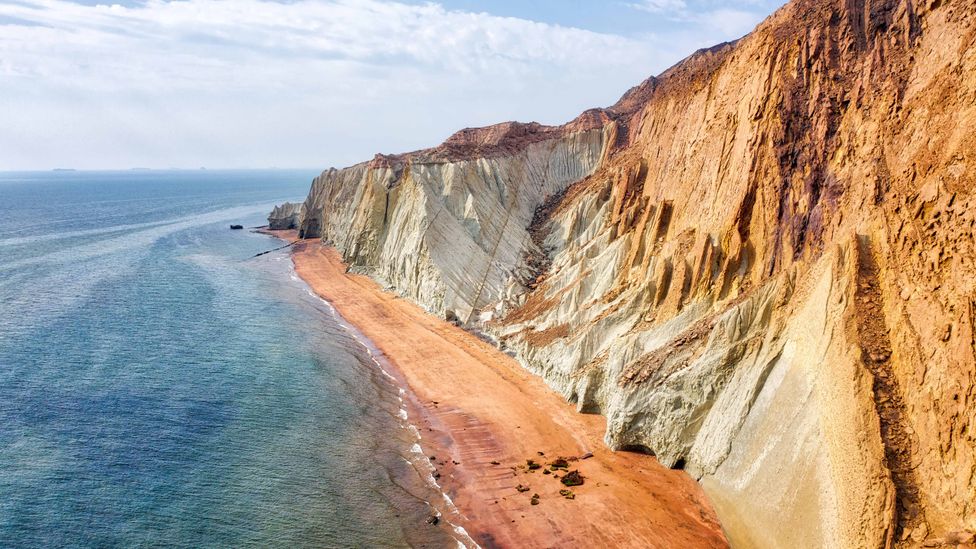"You should get a taste of this soil," said Farzad Kay, my tour guide on southern Iran's Hormuz Island, as we stood at the foot of a ruby-red mountain that loomed majestically over the shoreline, engulfing the beach and waves in a crimson shadow. I approached his suggestion with some trepidation, as I was yet to understand this mysterious, mineral-laden landscape.
Set 8km off Iran's coast amid the murky blue waters of the Persian Gulf, Hormuz is a teardrop-shaped shimmering salt dome embedded with layers of shale, clay and iron-rich volcanic rocks that glow in dazzling shades of red, yellow and orange due to the more than 70 minerals found here. Nearly every inch of Hormuz Island's 42 awe-invoking sq km imparts a story of its formation.
According to Dr Kathryn Goodenough, principal geologist at the British Geological Survey who has previously worked in Iran, hundreds of millions of years ago, shallow seas formed thick layers of salt around the margins of the Persian Gulf. These layers gradually collided and interlayered with mineral-rich volcanic sediment in the area, causing the formation of the colourful landmass.
"Over the last 500 million years, the salt layers were buried deeply by younger layers of volcanic sediment. Since the salt is buoyant, over time, it has risen through cracks in the overlying rocks to reach the surface and form salt domes," said Dr Goodenough. She added that these thick layers of salt, many kilometres below the land, are actually present across much of the Persian Gulf area.
This geological makeup has resulted in ochre-stained streams, crimson-hued beaches and enchanting salt caves. In fact, Hormuz is often called the "rainbow island" because of the spectrum of chromatic hues that it exudes. It's also home to what's thought to be the only edible mountain in the world, which Kay was encouraging me to try.

Locals believe that the salt found at the Goddess of Salt mountain has the power to release any negative energy (Credit: Saeed Abdolizadeh/Alamy)
The red soil on the mountain I was standing near, called gelack, is caused by haematite, an iron oxide thought to be derived from the island's volcanic rocks. Not only is it a valuable mineral for industrial purposes, it also plays an important role in local cuisine. Used as a spice, it lends an earthy flavour to curries and goes perfectly with the local bread called tomshi, which means "a handful of something".
"The red soil is used as a sauce," explained Maryam Peykani, Farzad's wife. "This sauce is called soorakh and is spread on flatbread as it is almost cooked. Apart from its culinary usages, the red soil is also used [in paintings by] local artists, dyeing, creation of ceramics and cosmetics."
Beyond the ruby-red mountain, there's plenty else to explore on Hormuz. In the island's west there's a spectacular salt mountain known as the Goddess of Salt. Extending more than a kilometre, its pale caves and sharp-edged walls are covered by shimmering salt crystals that look like the giant columns of a marble palace.
Locals believe that the salt possesses the healing power to soak up and release any negative energy, and Kay advised me to take my shoes off so my feet touched the salt dome. "The rock salt is known to release immense positive energy," he told me. "After having spent [time] in this valley, you are bound to feel much more invigorated, which is why the valley is also called the Energy Valley."
Similarly, in the island’s south-west is Rainbow Valley, a stunning display of multi-hued soil and vividly coloured mountains in shades of red, purple, yellow, ochre and blue. As I walked, I noticed patches of bright colours forming geometric patterns that glittered and gleamed as the sun's rays hit them.
In the nearby Valley of the Statues, rocks were weathered into fantastical shapes by thousands of years of wind erosion; with a bit of imagination, I could see birds, dragons and other mythical creatures. It was like admiring Earth's very own art gallery.

The island glows in shades of red, yellow and orange due to the more than 70 minerals found here (Credit: Lukas Bischoff/Alamy)
Despite the island’s surreal, kaleidoscopic natural colours, most travellers don't know about it. According to the Ports and Maritime Organization of Iran, just 18,000 visitors came here in 2019.
"This natural phenomenon is not fully discovered by world travellers despite its significant tourist attractions, historically and naturally," said Ershad Shan, another local, as I sank my teeth into a spicy, fragrant curry of sardines, red onion, lemon and orange, prepared using soorakh. "If more attention is paid to the infrastructural development of Hormuz, this island can be changed to be an important attraction for tourists."
Locals have started to offer home-cooked meals for tourists and driving rickshaws and motorcycles to transport people around the island. "We feel responsible for doing our bit for Hormuz. It's so rare and is a part of our identity," Shan said. "We feel an urgent need to contribute towards getting the world to take notice of this eco-heritage."
As I devoured my curry, it struck me that while Hormuz is without doubt a geologist's Disneyland, it is the edible soil, which is literally runs through the veins of its inhabitants, that make it truly special.








